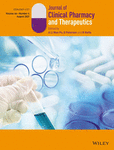Association between potentially inappropriate medication and adverse drug reactions in hospitalized elderly patients
Abstract
What is known and objective
The Beers, European Union (EU) and Screening Tool of Older Persons’ potentially inappropriate Prescription (STOPP) criteria were developed to improve the safe use of medicines in the elderly. However, the predictive validity of existing criteria to detect adverse drug reactions (ADRs) remains unexplored. The objective of the current study was to determine whether the 2019 Beers, 2015 STOPP or 2015 EU potentially inappropriate medicine (PIM) criteria were associated with ADRs.
Methods
A retrospective, cross-sectional investigation was conducted among older persons (≥60 years of age) admitted to a tertiary hospital in China between April 2019 and December 2019. PIMs were identified as per the Beers, EU and STOPP criteria definitions. ADRs were retrospectively evaluated by two clinical pharmacists using the Naranjo algorithm. Multivariate logistic regression was used to evaluate the factors associated with ADRs in the hospitalized patients.
Results and discussion
The study participants included 560 hospitalized patients (mean age 72.05 ± 8.15). The prevalence of patients receiving at least one PIM was 52.1%, 37.0% and 42.9% according to the Beers, EU and STOPP criteria, respectively. Univariate analysis showed that ADRs were associated with PIMs listed in the Beers criteria (OR: 2.093, 95% CI: 1.028–4.263, 0.042), but not with the STOPP-listed (OR: 0.536, 95% CI: 0.255–1.123, 0.098) and EU-listed PIMs (OR: 0.258, 95% CI: 0.118–0.563, 0.001).
What is new and conclusion
In contrast to the STOPP and EU criteria on PIMs, the Beers criteria were significantly associated with avoidable ADRs in hospitalized older persons.
CONFLICT OF INTEREST
The authors have no conflicts of interest in the study.
Open Research
DATA AVAILABILITY STATEMENT
Data available on reasonable individual request only due to privacy/ethical restrictions.




